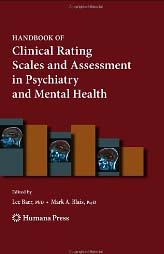Handbook of Clinical Rating Scales and Assessment in Psychiatry and Mental Health

Book provides tools to
integrate measurement
(April 2011 Issue)
“Handbook of Clinical Rating Scales and Assessment in Psychiatry and Mental Health”
Edited by Lee Baer and Mark A. Blais
Humana Press
New York, N.Y., 2010
By James K. Luiselli, Ed.D.,
ABPP, BCBA-D
Psychologists Lee Baer and Mark A. Blais have edited a useful and practical handbook for mental health professionals. They write: “The overarching goal of this handbook is to provide you, as a mental health clinician, with the knowledge and tools necessary to integrate measurement into your ongoing clinical practice.”
As Baer and Blais indicate in their introductory chapter, self-report instruments and clinician administered rating scales serve many functions. For one, how do you know objectively a client’s level of distress before treatment unless you quantify presenting symptoms? As treatment progresses, data from rating scales will verify whether there is clinical improvement or a need to revise therapeutic procedures. Additionally, you can justify your treatment to third-party payers by having positive outcome measures that are derived from rating scales.
Although Baer and Blais advise that readers have a basic understanding of psychometric concepts, you don’t have to be a master psychometrician to profit from the handbook. In total, there are 14 chapters, each one addressing a specific clinical disorder such as depression, anxiety, schizophrenia and bipolar disorder. The chapter authors briefly introduce their topic and then describe recommended “gold standard” rating scales. For each scale included in the chapters, you learn how it should be administered and scored, as well as its cut-off dimensions (to substantiate clinical acuity), reliability and validity.
One outstanding feature of the handbook is that the rating scales referenced in the chapters are reproduced in an appendix section. Being able to see these instruments will help clinicians decide about using them in day-to-day practice. Furthermore, you can judge whether several rating scales might be applicable for screening co-morbid disorders among complex clients, particularly those who do not volunteer information.
In addition to the factual details contained in the handbook, Baer and Blais convincingly dispel the myth that measurement in mental health is burdensome and overbearing. The book shows that clinical rating scales and questionnaire-like assessment tools can be adapted to each client’s life circumstances without imposing on the psychotherapeutic process. Their proposition is spot on: “Integrating a few select scales, like those included in this volume, into your routine clinical practice will benefit you and your patients.”
There is little to criticize about this handbook, although I would have liked to see a chapter about data summary and visual (graphic) presentation of rating scale scores. That is, many clinicians need to know how to plot measurement results so that a client’s behavior and symptom trends are revealed and can be analyzed to inform treatment decisions. Nonetheless, the Handbook of Clinical Rating Scales and Assessment in Psychiatry and Mental Health is a wonderful resource for students, trainees and established professionals. Regardless of one’s psychotherapy orientation, you owe it to yourself to read the book to become or to improve your skills as an empirical clinician.
James K. Luiselli, Ed.D., ABPP, BCBA-D, is senior vice president, applied research, clinical training and peer review at the May Institute in Norwood, Mass.
Learn more about the book: Handbook of Clinical Rating Scales and Assessment in Psychiatry and Mental Health (Current Clinical Psychiatry)
